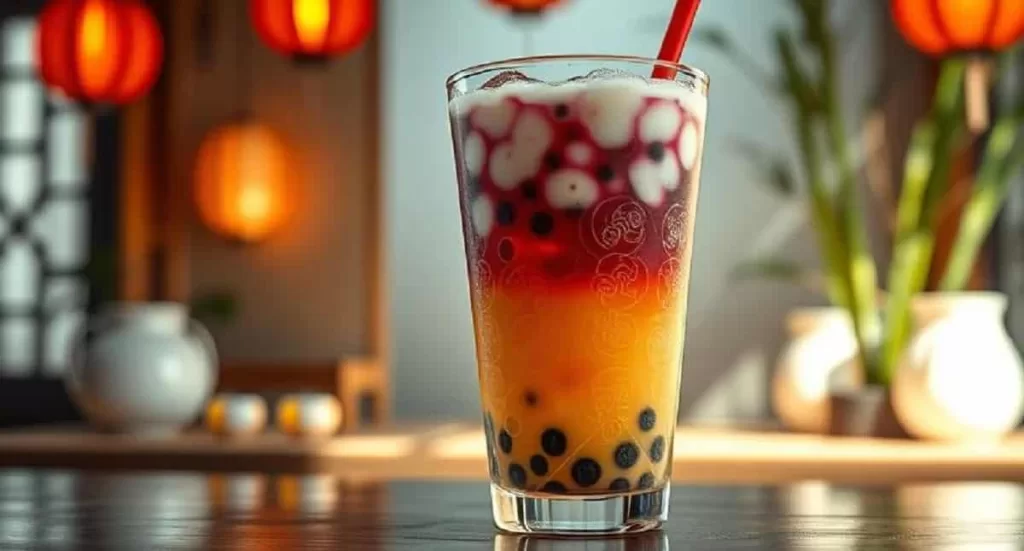FOOD & WINE
Wondering about Taichi Bubble Tea nutrition facts? Learn about the calories, carbs, sugar, and healthy options to make an informed choice.
BY KAZEEM ADELEKE, ARTCENTRON
Bubble tea, also known as boba tea, has taken the world by storm. With its unique combination of tea, milk, and chewy tapioca pearls, this Taiwanese-originated drink has evolved into a global sensation. One brand that has garnered significant attention is Taichi Bubble Tea, renowned for its diverse flavors and refreshing taste. However, when indulging in this popular drink, it’s crucial to understand the nutritional facts and ingredients to make an informed choice. To help you understand Taichi bubble tea nutrition facts, we explore everything you need to know and how it fits into your diet.
What Is Taichi Bubble Tea?
Taichi Bubble Tea is a variation of the traditional bubble tea that typically features a base of tea, either black or green, mixed with milk or fruit flavors. The defining characteristic of bubble tea is the chewy tapioca pearls (or boba) that sit at the bottom of the drink, adding texture and fun to the overall experience. Taichi Bubble Tea distinguishes itself through its carefully selected tea blends, the variety of toppings available, and the wide range of customizable sweetness levels.
While this drink may be a delightful treat, it’s essential to consider its nutritional profile, especially if you’re mindful of your calorie intake or sugar consumption.
Key Nutritional Facts of Taichi Bubble Tea
Understanding Taichi Bubble Tea nutrition facts can help you assess its impact on your overall health. Here are some general insights based on a standard serving of Taichi Bubble Tea, though the exact values can vary based on the specific ingredients and customization you select.
1. Calories in Taichi Bubble Tea
One of the most significant factors people consider when choosing bubble tea is the caloric content. The calories in Taichi Bubble Tea vary depending on several factors, such as the size of the drink, the type of tea used, and whether you opt for milk or a non-dairy alternative.
A standard serving of Taichi Bubble Tea with milk, tapioca pearls, and a moderate sweetness level contains approximately 250 to 400 calories. If you opt for less sugar or choose a fruit-based tea, you can potentially lower the calorie count. On the other hand, adding extra toppings like pudding, agar pearls, or red beans can increase the overall caloric content of the drink.
2. Carbohydrates and Sugars
Another key consideration is the carbohydrates and sugar content in bubble tea. The combination of tapioca pearls and sweetened syrups significantly contributes to the carbohydrate count, as well as the overall sugar content in the drink.
A typical serving of Taichi Bubble Tea contains 50 to 75 grams of carbohydrates, of which 30 to 50 grams can be sugar. For those watching their sugar intake, it is essential to either opt for reduced sweetness or choose sugar-free alternatives. However, it’s important to note that bubble tea is inherently sweet, and the combination of chewy pearls and flavored syrups can make it difficult to cut down on sugar entirely.
3. Protein Content in Taichi Bubble Tea
While bubble tea is not typically considered a high-protein drink, some versions may offer a modest amount of protein due to the milk or non-dairy alternatives used. The protein content of Taichi Bubble Tea usually falls between 5 to 7 grams per serving, especially when made with cow’s milk or soy milk.
If you’re looking to boost your protein intake, you might want to consider swapping your regular tapioca pearls for protein-rich toppings like grass jelly or chia seeds. These alternatives can help you add more nutritional value to your bubble tea without significantly increasing the calorie count.
4. Fat Content
The fat content in Taichi Bubble Tea varies depending on whether you choose full-fat milk, skim milk, or a non-dairy substitute like almond or oat milk. Typically, a regular serving made with whole milk may contain about 7 to 10 grams of fat. For those aiming for a lower-fat option, opting for skim milk or a plant-based milk substitute like almond milk can reduce the fat content.
Toppings like cheese foam or custard can further increase the fat content, so it’s wise to be mindful of your choices if you are watching your fat intake.
5. Fiber Content
Despite its sugar-heavy composition, Taichi Bubble Tea can provide a small amount of fiber, primarily from the tapioca pearls and any added toppings such as chia seeds or grass jelly. A typical serving of bubble tea may contain between 1 and 3 grams of fiber. Although this amount is modest, fiber can contribute to better digestion and satiety, helping you feel fuller for longer.
Customizing Your Taichi Bubble Tea for a Healthier Option

While bubble tea can be deliciously indulgent, you have plenty of options for customizing your Taichi Bubble Tea to suit your specific dietary goals. Here are some simple adjustments you can make to improve the overall nutritional profile:
1. Opt for Reduced Sugar or Sugar-Free Options
If you want to cut down on the sugar content of your bubble tea, most Taichi Bubble Tea shops offer the option to choose less sugar or no sugar at all. By adjusting the sweetness level, you can reduce your sugar intake and still enjoy the drink’s refreshing flavors. Some locations even offer sugar alternatives like stevia or monk fruit sweeteners, which provide sweetness without the added calories.
2. Choose Low-Fat or Plant-Based Milk Alternatives
To lower the fat content of your Taichi Bubble Tea, consider opting for low-fat milk, almond milk, or oat milk instead of whole milk. These alternatives are not only lower in fat but can also offer additional health benefits such as extra vitamins and minerals.
3. Add Nutrient-Rich Toppings
Incorporating healthier toppings into your Taichi Bubble Tea can enhance its nutritional value. For example, toppings like chia seeds, aloe vera, or grass jelly provide fiber, antioxidants, and essential fatty acids. You can also choose toppings like red bean or coconut jelly for a fun and nutritious twist.
4. Control Portion Size
If you’re concerned about the calorie count, consider opting for a smaller size or sharing a larger drink with a friend. By reducing the portion size, you can still enjoy the bubble tea experience while cutting back on excess calories.
5. Taichi Bubble Tea – A Delicious Yet Calorific Drink
Taichi Bubble Tea is a delicious and refreshing treat, but like all sweetened beverages, it’s important to enjoy it in moderation. With its varying levels of sugar, calories, and fats, it’s essential to tailor your choice to your personal dietary needs and health goals. By adjusting the sweetness, selecting healthier milk alternatives, and adding nutrient-rich toppings, you can create a more balanced and nutritious version of this popular beverage.
Ultimately, Taichi Bubble Tea can be part of a healthy diet when consumed mindfully, offering both indulgence and refreshment. Whether you’re a long-time fan of bubble tea or just trying it for the first time, understanding Taichi Bubble Tea nutrition facts will help you make the best decision for your health and enjoyment.
